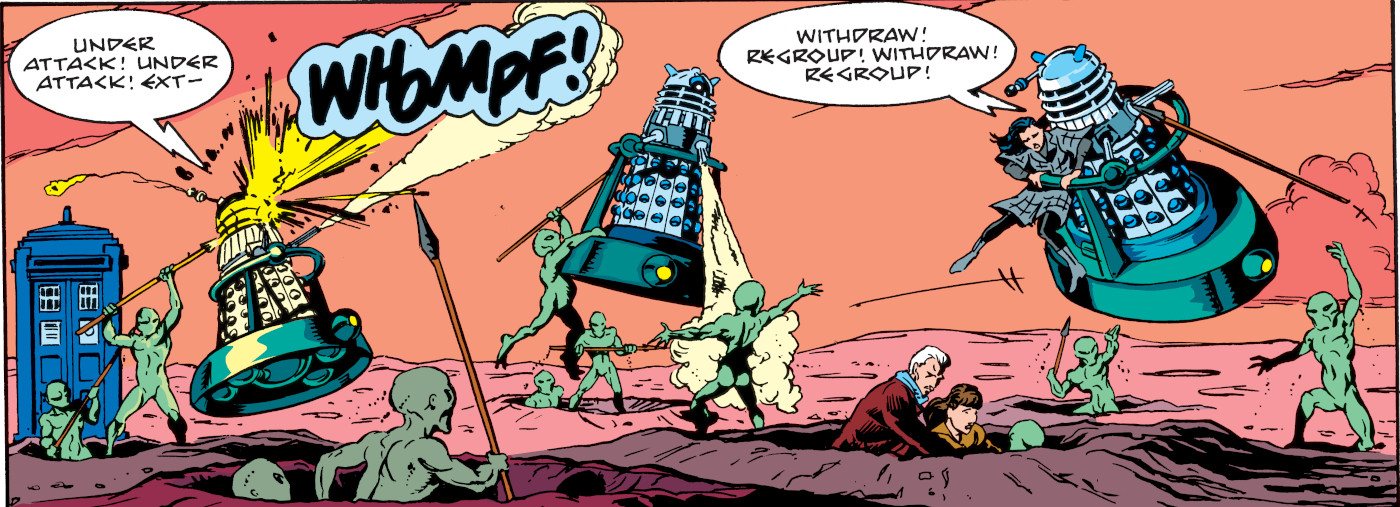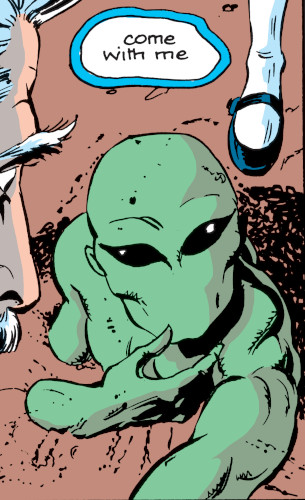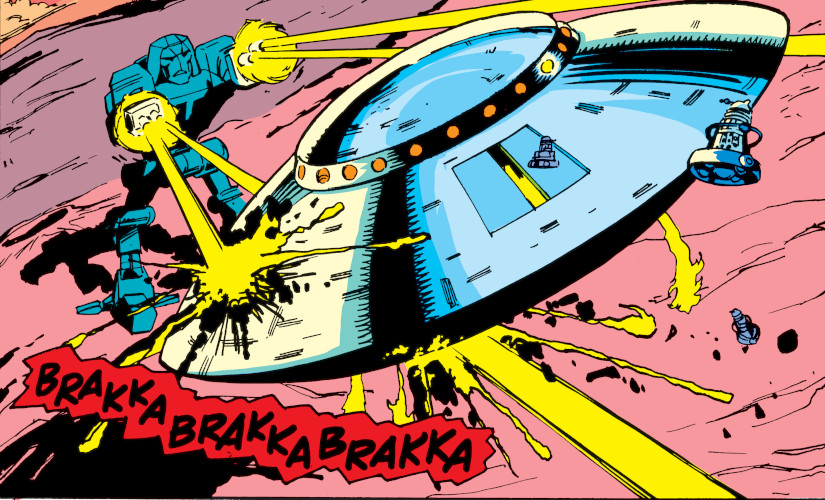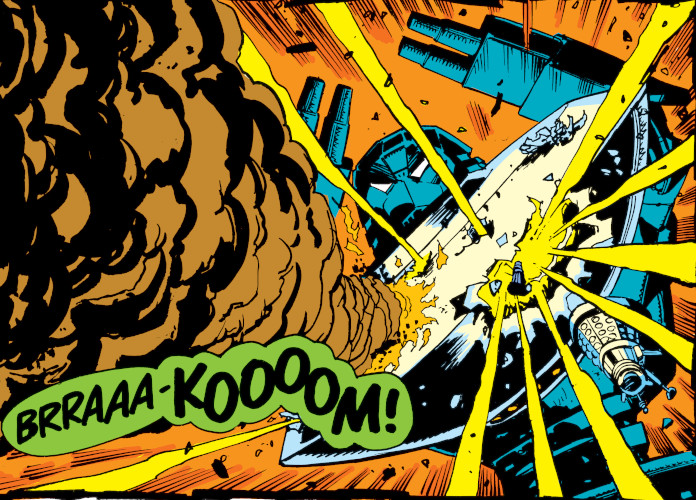 Classification:
Alternate
reality (Reality-26513) extraterrestrial
(Martian) race
Classification:
Alternate
reality (Reality-26513) extraterrestrial
(Martian) race MARTIANS
 Classification:
Alternate
reality (Reality-26513) extraterrestrial
(Martian) race
Classification:
Alternate
reality (Reality-26513) extraterrestrial
(Martian) race
Location/Base of Operations: Underground canals, the Mars Bubble, Mars
Known Members: None named
Affiliations: Doctor Who, Louise, Susan
Enemies: Daleks
First Appearance: Doctor Who Magazine Spring Special 1996 (February 1996)
Powers/Abilities: The Martians are a short (by
comparison to humans) but hardy race capable of tunneling swiftly
through the Martian soil. They are telepathic, allowing them to
communicate with others in whatever language the other person
understands.
They used to be a highly advanced race, with
the technology to construct vast underground canals, and to build giant
robot war machines. They may also have had the technology to alter
Mars' atmosphere (see comments). However they have lost much of
that knowledge, and the height of their weapon technology now appears to
be spears.
Traits: Formerly warlike, the Martians are a friendly but private race who normally avoid contact with offworlders (see comments). That said, they remain willing to fight invaders no matter what the odds against them, and to assist friendly travelers in distress. Perhaps as a side effect of their telepathy, they display empathy for others in distress.
Type: Bilaterally symmetric humanoid bipeds
Eyes: Two (on head, black with no visible sclera or irises)
Fingers: Three with an opposable thumb
Toes: Two
Skin color: Unrevealed (see comments)
Average height: 4'5" (see comments)
Distinguishing features: No visible mouths or noses/nostrils (see
comments)
History:
 (Doctor Who Magazine
Spring Special 1996 (fb) - BTS) - The Martians were once a
technologically sophisticated race, constructing a giant robot war
machine later known as the Martian Sphinx and constructing massive
underground canals. However some time in the distant past they suffered
a "ravaging" that wiped out most of their civilization; this may have
involved a change to their world's atmosphere that rendered it inimical
to their species (see comments). A small number of Martians
survived in the Mars Bubble, a region which still had an oxygen
atmosphere (see comments), living mostly in the canals and
guarding the Sphinx, now buried so that only its facial features were
noticeable beneath a covering layer of rock. The remaining Martians were
reduced to the technological level of stone-age humans, capable of
making spears and canal boats but apparently little else. Though they
had forgotten what the Sphinx really was, they felt it their duty to
protect it.
(Doctor Who Magazine
Spring Special 1996 (fb) - BTS) - The Martians were once a
technologically sophisticated race, constructing a giant robot war
machine later known as the Martian Sphinx and constructing massive
underground canals. However some time in the distant past they suffered
a "ravaging" that wiped out most of their civilization; this may have
involved a change to their world's atmosphere that rendered it inimical
to their species (see comments). A small number of Martians
survived in the Mars Bubble, a region which still had an oxygen
atmosphere (see comments), living mostly in the canals and
guarding the Sphinx, now buried so that only its facial features were
noticeable beneath a covering layer of rock. The remaining Martians were
reduced to the technological level of stone-age humans, capable of
making spears and canal boats but apparently little else. Though they
had forgotten what the Sphinx really was, they felt it their duty to
protect it.
Wanting a base from which to attack Earth the
Daleks eventually came to Mars; they exterminated the Martians when they
encountered them on the surface, killing many of the remaining natives.
The rest took refuge in the tunnels.
(Doctor Who
Magazine Spring Special 1996) - The human time traveler Doctor
Who, his niece Louise and granddaughter Susan came to Mars sightseeing,
wanting to visit the Mars Bubble and see the Sphinx. Almost as soon as
they arrive Daleks swooped in to confront them, but the Martians emerged
form the ground below to rescue the visitors, successfully extracting
Doctor Who and Susan; Louise however was captured by the retreating
Daleks. The Martians took their guests to their canals, and explained
how the Daleks had recently invaded and now intended to move on to "the
blue planet." Examining what appeared to be hieroglyphs inscribed into
the walls, Doctor Who realized that they were actually machine code, an
activation sequence for a giant robot, and that the Sphinx was actually
an ancient war machine. While Susan used the code to activate the Sphinx
and unleash it on the Daleks, Doctor Who used the distraction to slip
onto the Dalek saucer and rescue Louise. As such, Susan instructed the
Sphinx to attack only the Daleks outside, not the saucer, but when the
vessel rose into the air and with the Sphinx taking damage from
concerted Dalek attacks, the robot went out of control and began
blasting the ship too. To the horror of Susan and her watching Martian
companion the vessel crashed into the Sphinx, destroying both. The
Martian began to comfort Susan over the seeming loss of her family, but
their grief was only momentary as seconds later Doctor Who called out to
them, as he and Louise had managed to evacuate the Dalek craft using a
Dalek flying disc just before the ship was destroyed. With the invaders
destroyed, the three humans departed, leaving the Martians back in
control of their planet.
Comments: Created by Alan Barnes and Lee
Sullivan. The strip in the comic was in black and white, but while
working on this profile I stumbled across some panels that had been
colored by professional colorist Matt Webb. That color version so
enhanced the work that I felt that I had to use it here; Matt kindly
supplied both hi-res copies of the images and his permission to use them here.
For those who don't know the long and
convoluted history of Doctor Who: These Martians aren't from the reality
the TV series is based in, but from the reality of the two Amicus Doctor
Who movies that adapted two of the first Doctor stories for the big
screen, and which starred Peter Cushing as the human time-traveler
Doctor Who, rather than the alien (not then known as a Time Lord) known
as the Doctor.
With no visible mouth nor nostrils, it is unclear how or even if the Martians eat and breath; for that matter they also lack any visible orifices for ejecting bodily waste/ Additionally, despite seeming able to rapidly move through the ground - they emerge from what appeared solid earth almost as easily as Shadowcat can phase through solid matter (see image to left), and also open up wide holes swiftly enough to ambush Daleks above them (see main image) - they don't seem to have the kind of appendages that would facilitate this. It may be that their psionic abilities go beyond telepathy, allowing them to telekinetically shift the earth around them or to phase through solid matter, but if they possessed either of these abilities why not deploy them in combat with the Daleks? Alternatively, it might be that their telepathy is somewhat more developed than was clearly demonstrated, allowing them to not only communicate in a language their new allies could understand but also perhaps modified how the humans perceived them, making them appear more humanoid than they actually were.
It's also possible the lack of mouth is
related to some genetic manipulation. When Doctor Who visits Mars he
lands in the "Mars Bubble," which he describes as "one of the natural
wonders of the galaxy, a hundred-mile wide atmospheric pocket,
sustaining life on an otherwise dead world." But perhaps the Bubble
wasn't natural. The Martians clearly live in the Bubble, so presumably
an oxygen atmosphere was where they evolved, suggesting the rest of Mars
wasn't habitable to them. What if the ravaging that the Martians said
wiped out most of their people included the changing of the rest of Mars
to the lifeless atmosphere it now has in the real world. The Martians,
still at that time having advanced tech, managed to create a zone they
could survive in, with an artificially maintained atmosphere they could
breath, and then when that didn't prevent the surface becoming difficult
to live on, they also created underground tunnels to live in and store
their precious water supplies? They might have had mouths, noses and a
verbal language, but losing these was part of their attempts to survive
an increasingly hostile world - if they inadvertently strayed outside
the Bubble or it one day collapsed, not having open orifices leading to
their lungs might keep out the poisonous atmosphere prevalent on the
rest of Mars for a few precious seconds.
Calculating the average Martian height: On
p4, pan5 of the story we get about the only decent shot of a Martian
standing upright next to another character also standing upright (Doctor
Who) and on level ground. The Martian looks to be around the height of
Doctor Who's armpit. Human body proportions means the armpit is around 2
heads below the top of the body, and the body is around 7.5 heads tall;
that means the Martians are 73% as tall as Doctor Who. Peter Cushing was
6' tall, so 73% of that is just under 4'5".
Extrapolating their traits: The Martians were
clearly once more technologically adept and possibly warlike, given
their ancestors created the Martian Sphinx battle robot. They've lost
that tech though, as they fought the Daleks with spears. Given that
others had apparently visited the Martian Sphinx (as Doctor Who had
heard about it) but its origins were considered a mystery, they've
clearly avoided contact with other visitors to Mars. However, they also
came to the aid of the visiting humans, even at the cost of some of
their own, and one of the Martians displays empathy for Susan when it
appears both her grandfather and cousin-once-removed have been killed.
Profile by Loki.
CLARIFICATIONS:
Martians have no known connections to:
|
The Martian Sphinx was a giant robot around 60' tall that was voice activated and followed the instructions of a controller (possibly telepathic instructions, as when Susan commanded it she didn't appear to be issuing vocal orders). It was buried beneath the surface of Mars so that only the shape of its face, covered in a layer of earth, was visible, while its legs protruded into the hidden Martian tunnels below. A war machine, it was equipped with twin guns on each massive arm. After Doctor Who figured out its activation code his granddaughter Susan sent it into battle against the Dalek invaders, destroying most of them, but the heavy fire it sustained sent it berserk and it went out of control, blasting the launching Dalek saucer against Susan's instructions. The saucer crashed into the Sphinx, destroying both. --Doctor Who Magazine Spring Special 1996
|
|
 |
 |
images: (without ads)
Doctor
Who Magazine Spring Special 1996, p31 (p2 of
story), pan4 (main image)
Doctor
Who Magazine Spring Special 1996, p31 (p2
of story), pan3 (headshot)
Doctor
Who Magazine Spring Special 1996, p30 (p1
of story), pan2 (Martian Sphinx's buried face)
Doctor
Who Magazine Spring Special 1996, p34 (p5 of
story), pan2 (Martian Sphinx emerging from the ground)
Doctor
Who Magazine Spring Special 1996, p36 (p7 of
story), pan2 (Sphinx using its guns)
Doctor
Who Magazine Spring Special 1996, p36 (p7 of
story), pan6 (Sphinx destroyed)
Appearances:
Doctor Who Magazine
Spring Special 1996 (February 1996) - Alan Barnes
(writer), Lee Sullivan (art), Gary Gillatt & Scott Gray (editors)
First Posted: 03/31/2025
Last updated: 03/31/2025
Any Additions/Corrections? please let me know.
Non-Marvel
Copyright
info
All other characters mentioned or pictured are ™ and © 1941-2099 Marvel
Characters, Inc. All Rights Reserved. If you like this stuff, you should
check out the real thing!
Please visit The Marvel Official Site at: http://www.marvel.com
Special Thanks to www.g-mart.com for hosting the Appendix, Master List, etc.!